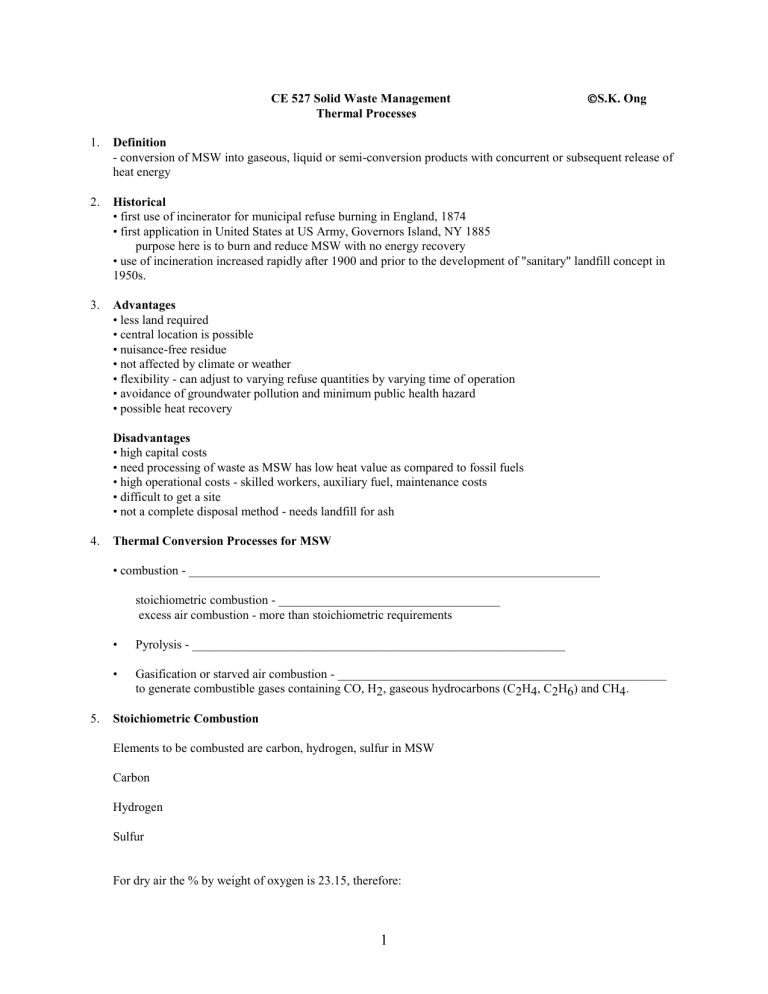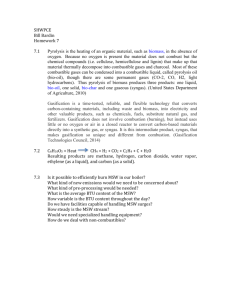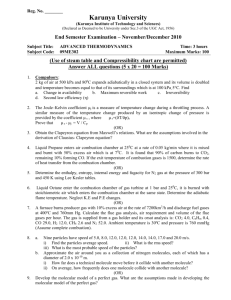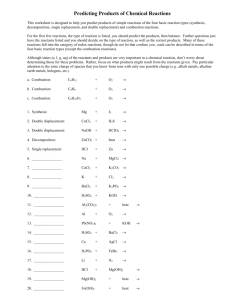S.K. Ong Definition

1. Definition
CE 527 Solid Waste Management
Thermal Processes
S.K. Ong
- conversion of MSW into gaseous, liquid or semi-conversion products with concurrent or subsequent release of heat energy
2. Historical
• first use of incinerator for municipal refuse burning in England, 1874
• first application in United States at US Army, Governors Island, NY 1885 purpose here is to burn and reduce MSW with no energy recovery
• use of incineration increased rapidly after 1900 and prior to the development of "sanitary" landfill concept in
1950s.
3. Advantages
• less land required
• central location is possible
• nuisance-free residue
• not affected by climate or weather
• flexibility - can adjust to varying refuse quantities by varying time of operation
• avoidance of groundwater pollution and minimum public health hazard
• possible heat recovery
Disadvantages
• high capital costs
• need processing of waste as MSW has low heat value as compared to fossil fuels
• high operational costs - skilled workers, auxiliary fuel, maintenance costs
• difficult to get a site
• not a complete disposal method - needs landfill for ash
4. Thermal Conversion Processes for MSW
• combustion - _________________________________________________________________ stoichiometric combustion - ___________________________________
excess air combustion - more than stoichiometric requirements
•
Pyrolysis - ___________________________________________________________
• Gasification or starved air combustion - ____________________________________________________ to generate combustible gases containing CO, H2, gaseous hydrocarbons (C2H4, C2H6) and CH4.
5. Stoichiometric Combustion
Elements to be combusted are carbon, hydrogen, sulfur in MSW
Carbon
Hydrogen
Sulfur
For dry air the % by weight of oxygen is 23.15, therefore:
1
air required to combust 1 lb of Carbon
1 lb of Hydrogen
1 lb of sulfur
=
=
= due to the inconsistent nature of solid waste and the inefficiency in mixing, stoichiometric amounts of air would be insufficient and excess air would be required to promote mixing and turbulence
• excess air, however, affects the temperature and the composition of the flue gases
6. Typical Waste-to-Energy Combustors
- see Figure 1.
- ___________________ and unloading into storage pit
- __________________ – use of overhead crane to load wastes into charging hopper
- possibility of bulky goods and hazardous wastes entering into the furnace.
- _____________ – refuse from charging hopper falls onto drying grates amd moves into burning area
- critical component of the incrinerator is the grate system.
- It’s function is to move the waste through the furnace, mixing the waste and allow injection of combustion air (underfire air).
Types of grates include:
- __________________________
- _________________________
- ____________________________
- The __________ assists in the combustion as well as cool the grates. It also helps to regulate the temperature of the combustion. Most incinerators operate in the range of _________________ o F
(980 – 1090 o C).
- Air blown into the combustion chamber above is called _________________________
- If temperature is below _______ o F then many of the plastics will not burn, resulting in poor combustion and emission of odorous compounds may occur
- If temperature is above __________ o F, emissions of furans, dioxins and volatile organics will be minimized
- If above ___________ o F, the refractories in the combustion chamber will not be able to withstand the heat.
- As shown in Figure 1, maintaining a temperature of 2000 requires about ______% excess air. o F in the combustion chamber
- gases may or may not pass through a secondary combustion chamber
- ______________________ – usually a boiler, conversion of water to hot water or to steam
- energy efficincies in typical systems are about 40%
- Two types of heat recovery
- ______________________________________
- walls of combustion chamber are lined with boiler tubes
- water is circulated and absorbs heat
- usually protected by refractory materials from excessive heat and abrasion
2
- ______________________________
- heat loss in combustion chamber of furnace is minimized
- hot gases pass through a separate chamber located externally to the combustion chamber – usually a waste heat boiler is installed
- Air pollution control equipment
- classes of air control equipment
- particulate control
- NOx control
- SO
2
and acid gas control
- CO and hydrocarbon control
- See Figure 7-11 – an alternate to the combustion chamber is the rotary kiln
- refuse travels down an ignition grate by gravity into a rotary kiln where combustion occurs
- rotary kiln provide the most turbulence of any grate system
- The efficiency of steam production depends on the quality of the fuel. The production of steam falls dramatically with increases in moisture in the fuel as well as the fractions of noncombustibles.
_(from Vesilind et al. 2002)_______________________________________________________________
As received heat value BTU/lb
_____ ______ ______ ______ _____
_____________________________________________________________________________________
Refuse
% moisture
% noncombustible
% combustible
15
14
71
18
16
66
25
20
55
32
24
44
39
28
33
Steam generated
Tons/tons refuse 4.3 3.9 3.2 2.3 1.5
___________________________________________________________________________________
7. Mass Burn versus RDF
- Combustion systems are characterized as either ______________ units or ___________________ units.
- Mass burn unit – no preprocessing of the solid waste prior to being fed into the combustion unit.
- RDF units – solid waste is processed prior to combustion to remove the noncombustible protion and to reduce the size of the combustible fraction thus producing a more uniform fuel at a higher heat value.
- Advantages and disadvantages of a RDF unit:
- heat value is more uniform and thus the amount of excess air needed required for combustion is reduced
RDF – ___________ % excess air, mass burn – _________________% excess air
- mass burn units require larger pollution control devices
- RDF can be stored until burn unlike raw MSW where storage time is limited
- processing of waste may not be cost effective and corrosion problems may exist in the combustion chamber as in mass burn units
- High Heating value (HHV) of mixed paper RDF is about _____________________ BTU/lb.
- ASTM has developed designations of RDFs (RDF -1 to RDF -2).
For example: RDF - 1 – unprocessed MSW (the mass burn option)
RDF - 2 - MSW shredded but no separation of materials
RDF - 3 - Organic fraction of shredded MSW – usually produced from a MRF
RDF - 4 – Organic waste produced from a MRF – shredded into a fine powder form, fluff
RDF - 5 - Organic waste produced from a MRF - pelletized
3
8. Environmental Problems with Combustion
Ash
________________
– recovered from the combustion chamber
- consists of inorganic materials as well as some unburned organics
______________
Materials in a typical MSW ash
- particulates removed from the gaseous emissions
__________________________________________
Material % by weight
_________________________________________
Metals
Combustibles
Ferrous Metals
Glass
Ceramics
Mineral
_____________________________________________
Comparison of ranges of metal concentrations (mg/kg) in soil. Refuse Combustibles, Bottom and Fly Ash
________________________________________________________________________________________
Metal Common soil Refuse Bottom Ash Fly ash
_________________________________________________________________________________________
Al 1,000 – 300,000 3,000 – 25,000 18,000 – 177,000 31,000 – 177,000
As 1 – 50 0 – 15 2 – 2,000 3 – 750
Ca
Cd
Cr
7,000 – 500,000
0 – 1
1 – 1,000
2,300 – 50,000
0 – 90
2 – 200
4,100 – 96,000
0 – 170
10 – 2,000
33,000 – 86,000
2 – 78,000
20 – 3,000
Cu
Fe
Hg
Ni
Pb
Zn
2 – 100
7,000 – 550,000
0
5 – 500
_________
10 – 300
20 – 3,400
500 – 45,000
0 – 2
1 – 90
30 – 1,600
40 – 8,000
40 – 18,000
400 – 480,000
0 – 4
7 – 600
30 – 44,000
90 – 128,000
200 – 5,000
3,100 – 320,000
1- 100
10 – 29,000
_____________
2,000 – 280,000
____________________________________________________________________________________________
Air Pollutants
- Sulfur dioxide is the primary pollutant
- Heavy metals is another concern (lead cadmium and mercury). Mercury is especially difficult to control because it volatilizes readily and escapes with the gaseous emissions.
- Of particular concern in waste combustion is the production of dioxin (polychlorinated dibenzodioxins
(PCDD)). Comes from two sources in wste-to-energy facilities: dioxins that are in the waste and not combusted in the furnance and dioxins that are created during combustion.
- forms from precursor compounds such as pesticdes, chlorophenols and chlorobenzenes or from the ineraction of lignin and chlorine compounds derived from PVC or inorganic compounds such as NaCl.
- Combustion control is the primary control strategy. California recommends minimum remperature of 1,800 o F
+ 190 o F with aminimum residence time of 1 sec.
4
9. Flue gas calculations - Example
Given the following proximate and ultimate analysis of a solid fuel compute the final composition of the flue gas (wt/wt) under stoichiometric conditions and 50% excess air
Ultimate Analysis
Wt (%)
Proximate Analysis
Carbon
Hydrogen
Oxygen
Sulfur
Nitrogen
78.3
5.4
8.7
6.0
1.6
Moisture
Volatile Matter
Fixed Carbon
Ash
9.7% (by wt)
19.6
60
10.7
5
10. Pyrolysis
• thermal processing in an atmosphere devoid of oxygen
• converts MSW into gaseous, liquid and solid fuels - sometimes termed as destructive distillation
• Overall reaction
__________ - any mineral ash or other non combustible material present in the waste plus "fixed carbon" - carbonaceous fraction of the original material that did not volatilize on heating
_ 11,000 - 12,000 BTU/lb
__________ - consists of combustible gases such as carbon monoxide, methane, hydrogen, ethylene and other higher hydrocarbons
_ 700 BTU/lb
_______________________________
- a tar or oil stream containing acetic acid, acetone, methanol and complex oxygenated hydrocarbons
_ 9,000 BTU/lb
Example
3(C6H10O5) ----> 8H2O + C6H8O + 2CO + 2CO2 + CH4 + H2 + 7C heat liquid
Relative quantities of products depends on
1. composition of waste
2. temperature - high temperature - more gases low temperature - more char
3. heating rate
11. Gasification
• process of partial combustion in which a fuel is deliberately combined with less than stoichiometric air
• partial combustion of MSW to generate a combustible fuel gas rich in carbon monoxide, hydrogen, some saturated hydrocarbons (primarily methane)
• the fuel gas is subsequently combusted
• Principal reactions:
- combustible components generated primarily by endothermic reactions
- heat to sustain process comes from exothermic reactions
6







